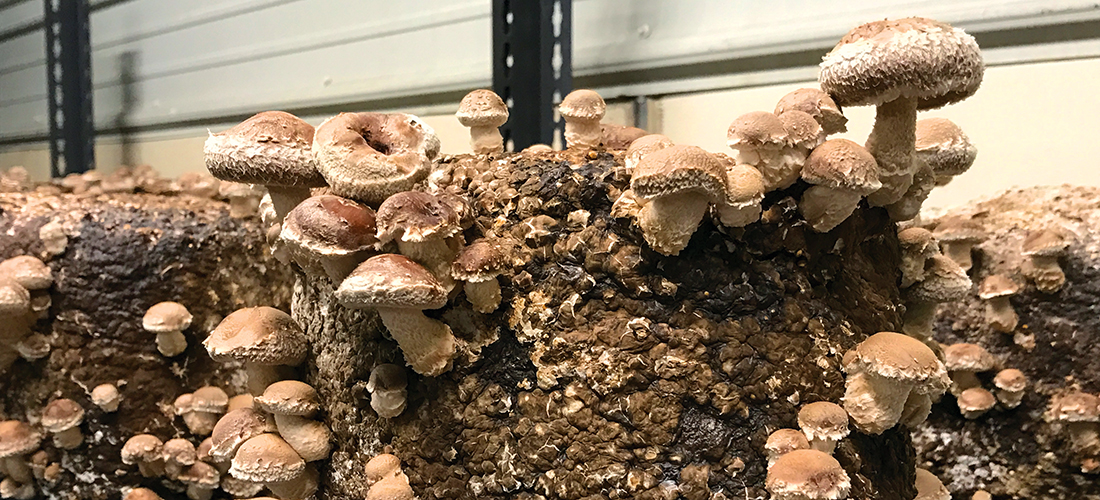
A family farm goes fungi
By Jan Leitschuh
Mushrooms add a depth of flavor to any number of dishes, meaty, with a hearty umami taste. Growing in dark, damp woodland places, who expected them to save the family farm?
Anyone with eyes has witnessed the shifts in rural agriculture, as the young folk and their young energies leave the farm for opportunities elsewhere, markets wither and long-stewarded properties sell out to housing developers. But some are bucking that trend. Welcome to one 21st century family farm in central North Carolina that has grabbed onto innovation as a way to survive.
Walk into one of the several “barns” on the pretty, rolling acreage here at Carolina Mushroom Farm in Willow Springs. No pink snouts or leathery golden leaves here anymore; hogs and tobacco have given way to at least three types of edible fungi.
Oyster mushrooms, pale and broad, aren’t hard to grow, says Shahane Taylor, 32, one of the four partners in the farm’s mushroom project. He walks to the sterile “prep” building, where special bags of straw are inoculated. Lined up like soldiers in a special 78-degree room are the bags of damp sterilized straw on which the inoculent thrives.
Oyster mushrooms double in size every 24 hours. They have broad, flat, upward-facing layers, and there is indeed a slight oyster-like appearance, unlike the more familiar button mushroom. You can grow oysters yourself, easily, in your kitchen. Besides the actual mushrooms, Carolina Mushroom Farm sells the grow bags too; if you don’t want to do your own research, gather materials, do the sterile prep and inoculation.
The taste of oyster mushrooms? Delicate and sweet. “Like chicken,” Taylor jokes, then adds, seriously, “like a chicken-seafood-y cross.” He likes a vegetable soup with oyster mushrooms.
Valuable shiitake mushrooms are a little trickier and slower to raise. Here, we move to another building where a sterilizing footbath awaits outside the door. Inside, there is another footbath, as well as a hand wash and special ventilation systems with HEPA filters to keep out molds and other contaminants, like foreign spores.
Step into yet another humid, warm room, and metal racks stacked with special blocks of compressed sawdust grow the umbrella-shaped brown caps of the delicate shiitake mushroom, famed for its savory taste and medicinal properties.
Shiitakes have a steak-like flavor that is prized in Asian cuisine, notably miso soup. Very umami, shiitakes are used to top meat dishes, added to stir-fries and used in soups. Shiitake pizza is Taylor’s favorite.
Shiitakes are one of the more popular forms of protein in China, and have a long tradition of medicinal use as well. Apparently, shiitakes have a strong antiviral effect due to natural interferons that inhibit viral replication. It has also been reported that the consumption of shiitake mushrooms lowers blood cholesterol levels.
In Asia, shiitakes are used to support cancer treatments. “Japan has developed an extract from shiitakes known as lentinan. The extract is used with patients undergoing traditional cancer therapy. In fact, in Japan mushroom extracts have become the leading prescription treatment for cancer. Lentinan may also prevent chromosomal damage induced by anti-cancer drugs. There are no known serious side effects,” reports the Mississippi Natural Products Association, a rural farmers’ cooperative.
But trickiest of all to grow are the baby portabella mushrooms.
Here at CMF they are reared on heavy trays of pasteurized compost, alive with beneficial microbes. “They are the most labor-intensive mushroom we grow,” says Taylor. “Baby bellas are especially sensitive in the early stages.”
But portabellas are very popular, so grow them they do. The smaller form, called cremini, is brown and a bit larger than a white button mushroom. They are mild, and can easily sub for the smaller white button ’shrooms in a recipe.
In their most mature form, the creminis grow out to the hefty, popular brown caps we know as portabellas. The large, beefy caps are terrific to grill, fabulous stuffed, and often substituted for meat among vegans.
Among the three varieties, Carolina Mushroom Farm currently produces 500 pounds of edible fungi a week. They are scaling up quickly to 1,000 to 1,500 pounds in the near future. The quality of the product is excellent, and packaged professionally. Yet, this ambitious venture only came into being in late 2015.
How did this happen to a small family farm in mid-North Carolina? You could start this tale with the farm itself, or begin it in the Marines.
In the Marines, Dion Heckman, 28 and the second of four partners, was a roommate and good friend of Taylor. When they got out of service together in 2010, they continued to hang out.
“We got along really well, it’s just one of those things,” says Taylor. “Dion had a girlfriend who lived near Raleigh, so I’d come visit. And when we got out, Raleigh happened to be where we landed.” There is muffled conversation, and then Taylor comes back with a laugh: “Dion says to tell you he’s the brains of the business.
Both went to Wake Tech on the G.I. Bill, and that’s where Taylor met dark-haired Sabrina in late 2010. Now his fiancée, Sabrina is the daughter of agricultural speaker Jerry Carroll. Jerry is the third of the four mushroom farm project partners. The fourth, Steve Carroll, is Jerry’s brother and a research scientist for BASF.
Dating Sabrina, Taylor naturally got to know her dad Jerry, and got on well with both parents.
Jerry Carroll had been a farm producer, with 6,000 hogs and fields of tobacco on the family land, but saw the agricultural writing on the wall. Ask him why he got out of hogs, and he’ll shoot back, “Twelve cents a pound!” He says at the end he was losing 40 cents per pound and it was the last hog operation in his growing county. With the tobacco buyout in the early 2000s, the golden leaf also left the farm rotation.
There they were, a family farm with 85 rolling acres and several stoutly built farm buildings, the latter nearly paid off. And no crop.
Eventually living on the farm, Taylor hadn’t thought about working there, even with his horticultural experience. His studies had been in business and accounting, and working in media communications. He also worked at a specialty gardening store, and at a hydroponic lettuce farm.
Heckman was drawn to the farm too. In their free time, they’d go fishing or target shooting there together, talk about the farm, especially the empty buildings. The expensive hog barns were just sitting there, used as farm storage. “We wanted it to be a working farm again,” says Taylor.
Pam Lockamy — Jerry and Steve’s sister — did her research and decided to build a new event space for weddings, to bring agritourism dollars to the throttled-back farm. Her husband, Ray, was looking to retire, and a wedding venue was their retirement plan. A beautiful red barn event space now marks the entrance to the farm, smelling of fresh pine lumber as the family works to complete the lofty interior.
With that plan in the works, the guys returned to look at production again. But producing what?
Jerry Carroll kept staring at the hog buildings. They were strong, well-kept and built to be sterilized. He wondered if there wasn’t a way to use this wasted asset. One day he turned to Taylor and asked the critical question: “What do you know about mushrooms?”
The answer “not much” was no deterrent. “The buildings they grow mushrooms in look just like what we have,” Carroll said.
“We had looked into strawberries,” says Taylor, “but there are a lot of strawberry growers and we wanted something unique. We looked up the top 10 most profitable greenhouse enterprises, and mushrooms were in the No. 2 spot.”
What was No. 1? “Marijuana,” he laughs. “Wouldn’t work here.”
Taylor started on a steep course of research, pulling his buddy Heckman along with him. “To do the scale we wanted to do, we knew we’d need a good team. We’d been best friends, Heckman knew the farm, so it seemed like a natural fit.” So in an era when the average age of the farmer in North Carolina is around 60 years, these two young Marine buddies joined their energies with brothers Jerry and Steve to form a partnership.
Taylor and Heckman began their research at the end of 2015. “When I say we immersed ourselves in it, I mean, we immersed ourselves in it,” Taylor laughs. “It was like going back to school. We’d all been in ag or hort backgrounds, but none of us had grown a mushroom.”
Turns out, the buildings were a perfect fit. Production began in 2016, and by autumn their product was not only showing up in restaurants but in the produce boxes of the local community cooperative, Sandhills Farm to Table, to great acclaim. On the very day of their first SF2T delivery, Sabrina also gave birth to their son, Addelynn.
The family farm, at least on this patch of ground, is not dying out. There is new life on these 85 acres, as the next generation reverses the trend and puts its energy into the age-old business of growing a crop for market.
Cream of Mushroom Soup
2 tablespoons butter
1/2 pound sliced fresh mushrooms
1/4 cup chopped onion
6 tablespoons flour or arrowroot
1/2 teaspoon salt
1/8 teaspoon pepper
2 cans (14 1/2 ounces each) chicken broth
1 cup half-and-half cream
In a saucepan, heat butter over medium-high heat; sauté mushrooms and onion until tender. Mix flour, salt, pepper and one can broth until smooth; stir into mushroom mixture. Stir in remaining broth. Bring to a boil; cook and stir until thickened, about 2 minutes. Reduce heat; stir in cream. Simmer, uncovered, until flavors are blended, about 15 minutes, stirring occasionally. Yield: 6 servings. PS
Jan Leitschuh is a local gardener, avid eater of fresh produce and co-founder of the Sandhills Farm to Table Cooperative.





